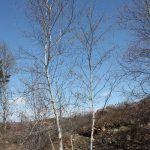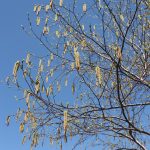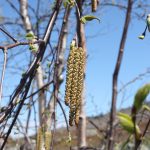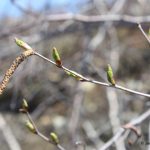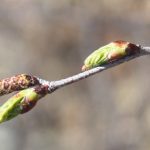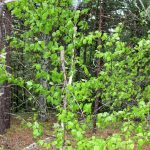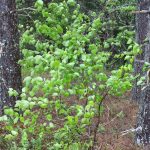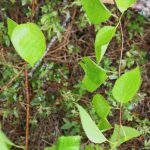Paper birch
Prepared by Jennifer L. D’Appollonio, Assistant Scientist, University of Maine, Orono, ME 04469. Updated February 2018.
Scientific name: Betula papyrifera Marsh.
Common name(s): paper birch, white birch, paperbark birch, canoe birch
Links: USDA PLANTS Profile, NPIN Profile, Go Botany
Images: (to see enlargements [PC]: click on image, then right click and choose “view image”)
- early May, mature bark
- flowering, early May
- flowers
- expanding leaves
- leaves and flower
- young bark
- leaf detail
Description:
-distinctive white bark
- peels off in “papery rolls”
-elastic young saplings
-seeds are winged and wind dispersed
-can reach a height of 70 feet and 12 inches in DBH
– may be confused with B. cordifolia, which has heart shaped leaves and was formerly thought to be a variety of B. papyrifera, or B. populifolia, which also occurs in wild blueberry fields; see left sidebar on Go Botany webpage
Habitat:
-cold climates
-forest edges
-woodlands
Natural History:
-source of skin for the traditional birch bark canoe
-used to shape snowshoe frames
Wildlife benefits:
-beavers eat the pink inner bark
-snowshoe hare eat the young seedlings
-over browsed by deer, moose, porcupines, and hares
-defoliated by
- the forest tent caterpillar (Malacosoma disstria)
- the birch skeletonizer (Bucculatrix canadensisella)
- the birch leafminer (Fenusa pusilla)
- birch leaf-mining sawflies (Heterarthrus nemoratus and Profenusa thomsoni)
- the birch casebearer (Coleophora serratella)
- the saddled prominent (Heterocampa guttivitta)
- the gypsy moth (Lymantria dispar)
- in Alaska, the spearmarked black moth (Rheumaptera hastata)
Sources:
Go Botany. “Betula Papyrifera Marsh.” Betula Papyrifera (Paper Birch): Go Botany, 2021, gobotany.nativeplanttrust.org/species/betula/papyrifera/.
Safford, L O, et al. “Paper Birch.” Betula Papyrifera Marsh, USDA, www.srs.fs.usda.gov/pubs/misc/ag_654/volume_2/betula/papyrifera.htm.

